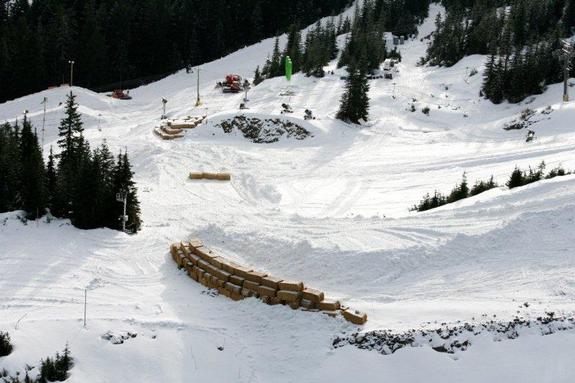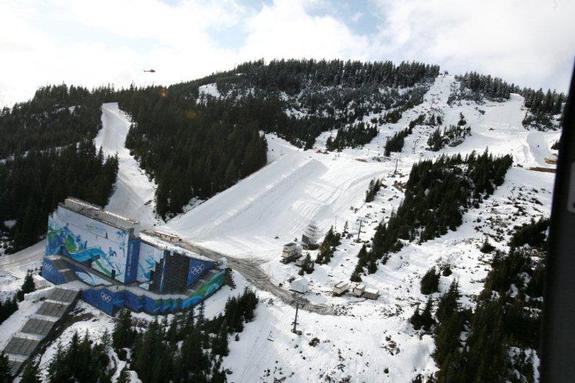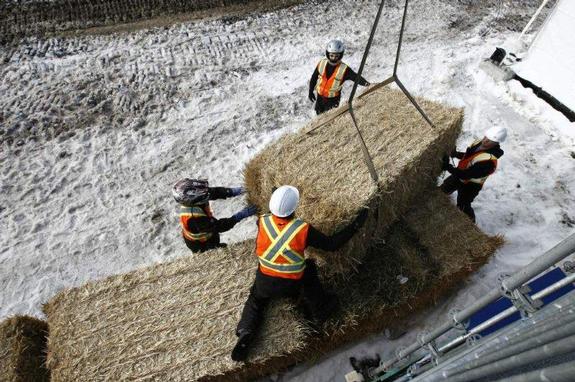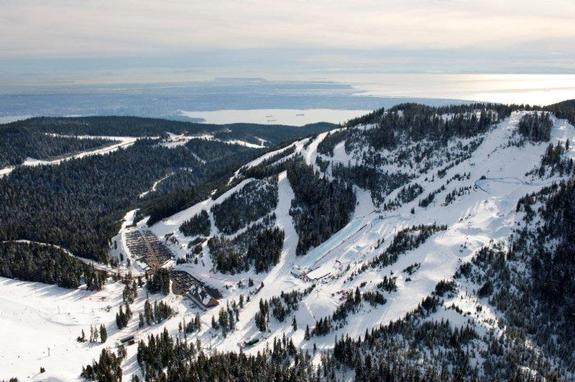Olympic snowboard preparations
Snow is finally falling at Cypress Mountain and the games are ready to start in Canada
There's been plenty of discussions centering around the unseasonable warm weather that has hampered preparations at Cypress Mountain, but the process construction of the courses have taken.

Cypress Mountain Olympic 2010 boardercross preparations
Copyright: VANOC/COVAN Getty-images
Snowboard Halfpipe Construction begins with a dirt in-ground structure. When weather is cold enough, snow is packed onto the dirt. A laser level and display screen help to push and pack snow onto the halfpipe to the correct specifications, building it 160 metres long, 19.5 to 20.5 metres wide, lip to lip, with an 18 degree slope and 6.5 metre high walls as set by FIS standards.

Olympic 2010 boardercross & Halfpipe with Grandstand
Copyright: VANOC/COVAN Getty-images
Once all snow is pushed onto the course, the walls are built up with snowcats; trimming the face of the pipe wall to get a rough shape. The surface of the halfpipe is finished using a Zaugg, an implement attached to the front of a snowcat and cuts the exact radius into the pipe walls.
Once machine work is done, hand shaping crews come in with rakes and shovels to do the finishing touches.
The snowboard cross event will run February 15 & 16 and ski cross on February 23 & 25. Between the two events modifications will be made to the 1.1 kilometre course.
• Some ski cross banks will be filled in so they are less steep.
• Some jumps will be lengthened and the second corner will be pushed out five to eight feet to accommodate the faster speeds of ski cross racers.
• Some technical start features will be removed to accommodate long skis and other course features will be modified to meet FIS specifications.
• Both the snowboard cross and ski cross course will include seven corners, three hip jumps (that may act as corners) and approximately 18 jumps. The highest jump is approximately 25 feet from lip to landing.

Cypress Mountain Olympic 2010 boardercross preparations
Copyright: VANOC/COVAN Getty-images
The course is constructed with snowcats moving snow into the field of play and the areas where snow is needed for features, such as jumps, starting from the top of the course to bottom.
Forms made of lumber are used to construct the base of features and conserve snow.
After the snowcats create the rough form of the course, fine shaping is done using hand tools such as shovels and rakes. The start gate is installed at the top and safety
nets are installed along the course.
The upper section of the course is on steeper terrain and requires more snow in order to correct the angles while the lower section is on a less steep pitch and requires less
snow to construct. The course is cleared of new snowfall to maintain the original, firm running surface. During racing, grooming is done by hand or side-slippers. After competition or training the course is groomed with snowcats.

Cypress Mountain Olympic 2010
Copyright: VANOC/COVAN Getty-images
Parallel Giant Slalom The 527 metre PGS course intersects with the Snowboard and Ski Cross course in two locations. After ski cross events finish on February 25, the areas that intersect will be cleared of all features and the snow will be moved off the course to leave the hard packed snow base clean and open.
The best conditions for PGS are very hard packed snow. The course is 45 metres wide with a vertical drop of more than 170 metres.